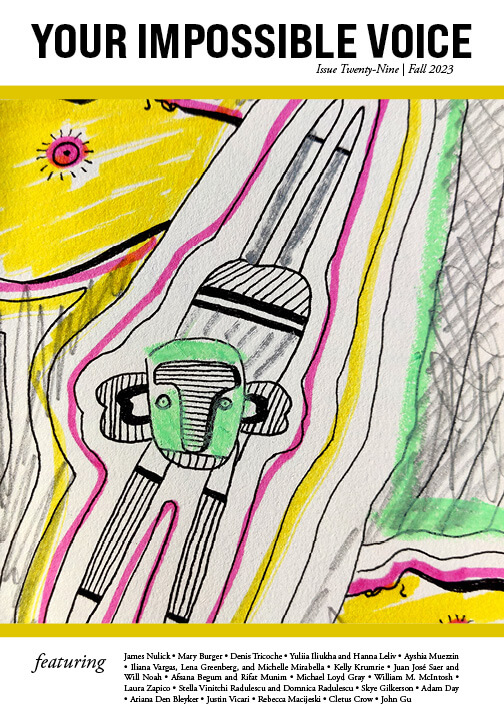Issue 29 | Fall 2023
About the About
Mary Burger
Story is, you come up over the rise and the coastal meadow spreads out in front of you all the way to the cliff, the grass bends in waves and the water beyond it is a steely rippling sheet.
We are always reading. Finding signs and putting them into relation.
We find a reason for why the jaguar did or didn’t attack today. We want there to be a reason. A set of conditions that we can work with to get the outcome we desire. To prevent the jaguar attack next time. To get the meat that we and the jaguar are competing for.
If some harm comes from the jaguar—the jaguar kills our chickens, the jaguar kills our child—we say it is the embodiment of a demon, a displeased ancestor whom we need to placate. If some good comes—if we find the remains of a jaguar kill, the still-fresh limbs and hindquarters of a wild pig—we say it is the gift from an ancestor in jaguar form, appeasing us, caring for us. Story is our companion, traveling alongside us but on its own path.
The power of our symbolization to manipulate the environment means we are often the most successful predators. We know how to deceive our prey—to startle the monkey so that it jumps out of the tree, thinking a jaguar is in pursuit—only to jump into the path of our weapon.
But our surplus of symbolization means we can make stories of stories, in signs that refract so deeply we can’t trace their path back to the world.
Model for a narrative interface:
Faultline
Juncture of two things similar enough to impact one another. The fault is not that they meet, but that their meeting is never resolved. They continue to co-disrupt. To co-evolve.
My mother read to me, Dr. Seuss and Little Golden Books and nursery rhymes and fairy tales and a special well-worn stack of Santa books that came out just at Christmas. And many stories of Jesus from a heavy gilt-edged picture book, of Jesus in robes, Jesus with animals, Jesus in markets and temples and plazas with other men and some women in robes. Jesus dying, Jesus being laid in a tomb, Jesus’ tomb found empty one day. Jesus reappearing, alive again, delighting everyone, and then leaving them all to finally go on up to heaven. Jesus, a gentle man with a powerful father, a father who did not prevent the worst things from happening to his son, but who came through for him, if rather impersonally, in the end.
Model for a narrative interface:
Epithelium
The meeting place of self and world. A membrane, permeable and impermeable. Vulnerable and protective.
Books, clothes, toys cast off by my older brothers and sisters showed up among my childhood things. The learn-to-read book Round About, signed on the flyleaf in careful block letters by the sister who’d used it twenty years before. In a more conventional family, it would have been my parents’ childhood belongings and experiences that I absorbed, but their childhoods were another twenty to thirty years removed from even a generation before me, the artifacts of their own childhoods already buried beneath their decades of parenthood.
Round About had a shiny green clothbound cover stamped with the title and a drawing of a striped spinning top, in black with yellow highlights. A book about toys, a book about how to play. Inside, on the thick cottony pages, fluid line drawings of a girl and a boy, the girl in braids and a skirt, flirty but innocent, the boy in a striped t-shirt and rolled-cuff jeans, both of them in slouchy socks and lace-up leather shoes. The boy more often than not took the lead, to spin the top, to throw the ball, while the girl watched, smiling and clapping. The words in the book were pointers, exclamations, captions, to reinforce what the pictures already explained, in type at least thirty points high and no more than ten or fifteen words to a page.
The erasures enacted through interpolated rules, which materialize only in being unknowingly violated, can be measured in the force required to maintain them.
Adulthood was as remote as my absent older siblings, not an outcome I could extract from observing my parents, who were entities unto themselves and not a correlative of what could someday happen to me.
I had no understanding of sexual differences as they applied to children, did not know how some children became women and others did not. Did not know all that wearing a skirt or not wearing a skirt would entail. Knew only that there was a future that was coming from somewhere behind me, stealthy predator.
The events that we outlive and relive, the forms and varieties of the benevolent and the malevolent, transform unexpectedly from one into another.
A narrative of memory being seized. Expropriated. Of being expelled from one’s memory, and trying to reinhabit it. Seizing onto memory in the process of its scattering, building the uncertainties and aporias into the story. Because how they got there is part of the story. Is really the story itself. The story of a memory denied to the rememberer.
Weigh the costs of recounting violence, even as you plunge right in.
Model for a narrative interface:
Dendrite
The branching arms that extend from the neuron cell body to receive the stimulus and carry it back to the cell, which sends the stimulus through the axon to the dendrites of other cells.
Violence done to the body, to a suite of bodies, an affiliation of bodies, that stymies the subject-centered narrative, that disperses the subject through the sites and scenes of other bodies and their desubjectifications. Story that works like a spell to contradict the violation, to overpower it. That assembles these dispersed parts, that recognizes this violation without yielding to it.
Story is, you can’t see the surf crashing on the shoreline ahead of you, it’s out of sight forty feet below the bluff. You keep going.
Story is, you come up to the edge of the bluff, just before the place where it would crumble under your weight. You look down at the surf smashing, shattering, rearing back, the surf that rolls up, attacks, and explodes, then collects itself and drains away. The surf that splinters in a spectrum of black-blue, green-blue, white-blue, and foamy white, against the black-green-brown-green ridges of rock that erupt from the water parallel to the shore, horizontal bands of an even more ancient seabed tipped on its side at this collision site more than a hundred thousand years ago. You make your way down a slanted rock shelf, you find an outcrop that matches the curve of your back, you lie against the slab with your head back, your eyes closed, and fall into the rhythm of the surf like sheltering inside a heartbeat, continuous, variable.
Model for a narrative interface:
Pearl
The nacre applied, layer after layer, to heal the injury, is only incidentally a gem. To the shellfish it is a memory. A telling.
About the Author
 Mary Burger’s piece “About the About” took form during a residency at This Will Take Time in Point Arena, CA, co-sponsored by the San Francisco literary organization Small Press Traffic. The piece owes a debt to How Forests Think by Eduardo Kohn, Total Recall by Samantha Giles, and Ban en Banlieue by Bhanu Kapil for their examples. Mary is the author of the novella Sonny and several prose and poetry collections, including Then Go On and A Partial Handbook for Navigators. Her work has appeared in a variety of literature and humanities journals, including The Brooklyn Rail, The Denver Quarterly, GeoHumanities, The Journal of Narrative Theory, and New American Writing. She lives in Oakland, CA, where she’s also a visual artist.
Mary Burger’s piece “About the About” took form during a residency at This Will Take Time in Point Arena, CA, co-sponsored by the San Francisco literary organization Small Press Traffic. The piece owes a debt to How Forests Think by Eduardo Kohn, Total Recall by Samantha Giles, and Ban en Banlieue by Bhanu Kapil for their examples. Mary is the author of the novella Sonny and several prose and poetry collections, including Then Go On and A Partial Handbook for Navigators. Her work has appeared in a variety of literature and humanities journals, including The Brooklyn Rail, The Denver Quarterly, GeoHumanities, The Journal of Narrative Theory, and New American Writing. She lives in Oakland, CA, where she’s also a visual artist.
Prose
Excerpt from novel-in-progress Plastic Soul: On the Destructive Nature of Lava James Nulick
About the About Mary Burger
Ellipse, DC Denis Tricoche
Excerpt from My Women Yuliia Iliukha translated by Hanna Leliv
In the East John Gu
Fire Trances Iliana Vargas, translated by Lena Greenberg and Michelle Mirabella
Excerpt from Concentric Macroscope Kelly Krumrie
Autumn Juan José Saer, translated by Will Noah
Pen Afsana Begum, translated by Rifat Munim
The Game Warden Michael Loyd Gray
Current and Former Associates William M. McIntosh
Take Care Laura Zapico
Poetry
I am writing the dream Stella Vinitchi Radulescu, translated by Domnica Radulescu
and finally, life emerging
and the night begins
Letter to the Soil Skye Gilkerson
A Flight Adam Day
The World Ariana Den Bleyker
What We Held in Common Justin Vicari
The Shame of Loving Another Poet
How to Keep Going Rebecca Macijeski
How to Lose Your Fear of Death
How to Paint the Sky
Eternal Life Cletus Crow
Cover Art
Deep Dive Ayshia Müezzin

